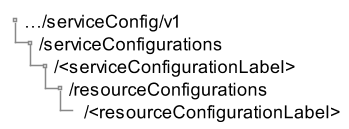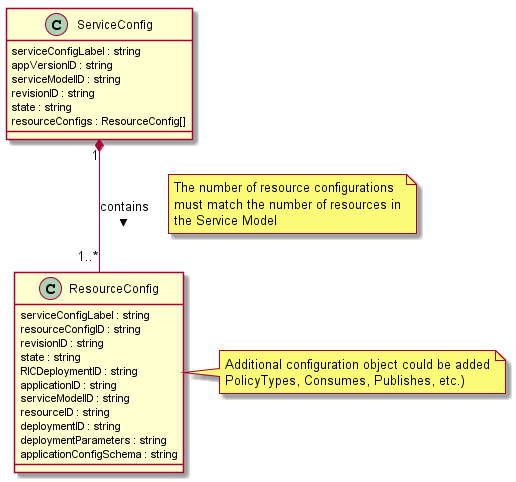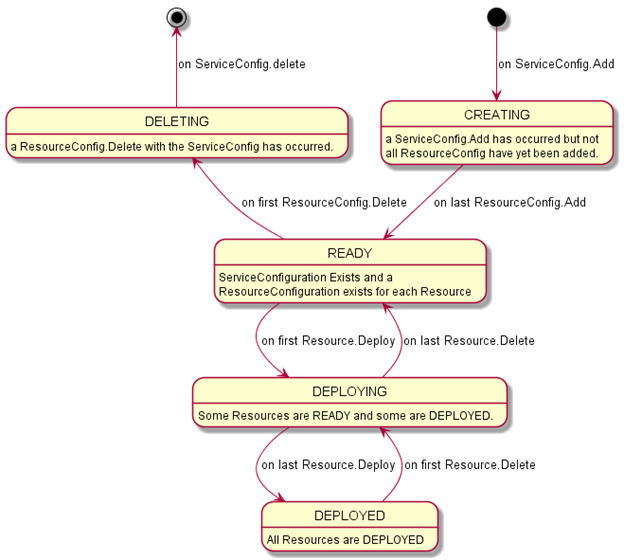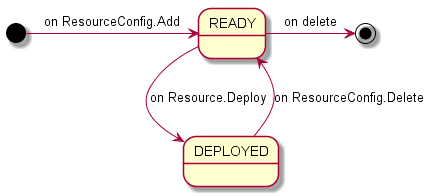SMO - ServiceConfiguration
The ServiceConfiguration provides a collection point for future or deployed configurations. Only Services which are available can have a configuration created. A configuration for a "Deployed" instance cannot be deleted. The Service Resource Configuration join a runtime location with a service instance at that location.
For the purposes of this implementation we will assume the following:
- The Controller will be RESTful from the service endpoint of {apiRoot}/serviceConfig/v1. The initial REST resource tree is show below.

Click here to view plantUML...
@startsalt
{
scale 1.5
{T
+…/serviceConfig/v1
++/serviceConfigurations
+++/<serviceConfigurationLabel>
++++/resourceConfigurations
+++++/<resourceConfigurationLabel>
}
}
@endsalt
- The Service Configuration Model is represented in the class diagram below

Click here to view plantUML...
@startuml
Class ServiceConfig {
serviceConfigLabel : string
appVersionID : string
serviceModelID : string
revisionID : string
state : string
resourceConfigs : ResourceConfig[]
}
Class ResourceConfig {
serviceConfigLabel : string
resourceConfigID : string
revisionID : string
state : string
RICDeploymentID : string
appVersionID : string
serviceModelID : string
resourceID : string
deploymentID : string
deploymentParameters : string
applicationConfigSchema : string
applicationConfig : string
}
Note right: Additional configuration object could be added\nPolicyTypes, Consumes, Publishes, etc.)
ServiceConfig "1" *-- "1..*" ResourceConfig : contains >
Note right on link
The number of resource configurations
must match the number of resources in
the Service Model
End note
@enduml
The ServiceConfiguration record in the Model Catalog follows a Stateful lifecycle. The ResourceConfigurations follow a sub-state model. The State can be updated with a partial update (PUT) as long as the current revisionID is supplied as a query parameter. Upon a successful update the revisionID will be changed by the system to a newly generated value. Deletes can only occur if the object has returned to its initial state.
The valid values for ServiceState are "READY", "INPROGESS", and "DEPLOYED". The state transitions allowed are:

Click here to view plantUML...
@startuml
[*] -down-> CREATING : on ServiceConfig.Add
CREATING -down-> READY : on last ResourceConfig.Add
READY -down-> DEPLOYING : on first Resource.Deploy
DEPLOYING -up-> READY : on last Resource.Delete
DEPLOYING -down-> DEPLOYED : on last Resource.Deploy
DEPLOYED -up-> DEPLOYING: on first Resource.Delete
READY -up-> DELETING : on first ResourceConfig.Delete
DELETING -up-> [*] : on ServiceConfig.delete
CREATING : a ServiceConfig.Add has occurred but not
CREATING : all ResourceConfig have yet been added.
DELETING : a ResourceConfig.Delete with the ServiceConfig has occurred.
READY : ServiceConfiguration Exists and a
READY : ResourceConfiguration exists for each Resource
DEPLOYING: Some Resources are READY and some are DEPLOYED.
DEPLOYED: All Resources are DEPLOYED
@enduml
The valid values for ResourceState are "READY" "DEPLOYED". The state transitions allowed are:

Click here to view plantUML...
@startuml
[*] -right-> READY : on ResourceConfig.Add
READY -right-> [*] : on delete
READY -down-> DEPLOYED : on Resource.Deploy
DEPLOYED -up-> READY : on ResourceConfig.Delete
@enduml



